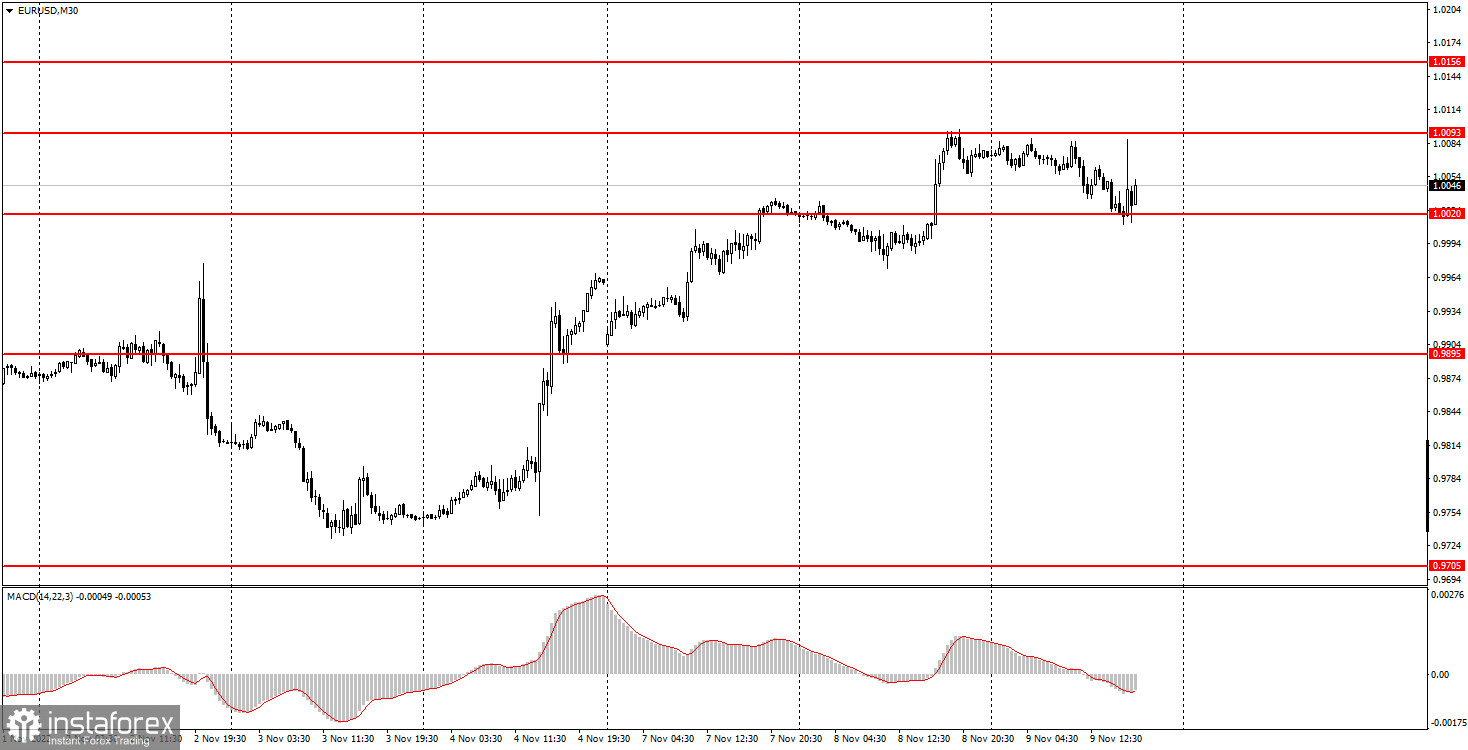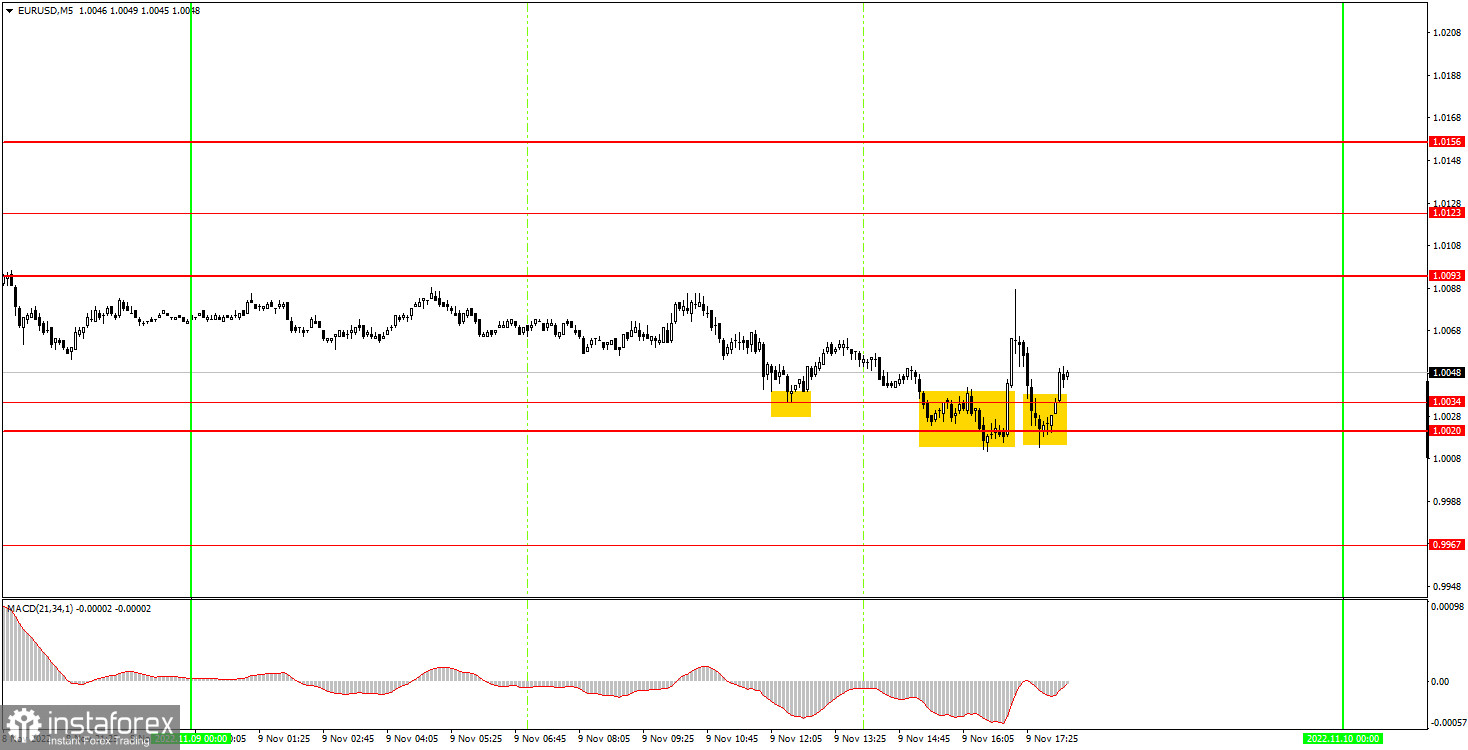Analyzing trades on Wednesday:
EUR/USD on 30M chart

On Wednesday, EUR/USD was trading slower and with a less pronounced trend than in the previous sessions. For the most part of the day, the pair was hovering between 1.0020 and 1.0093. So, we can state that the pair was trading within an intraday flat channel. The trajectory of the pair on Wednesday was fully consistent with the lack of fundamental and macroeconomic backgrounds. Yet, trading activity increased in the North American session for no obvious reason. Of course, the ongoing midterm Congressional elections in the US have their implications for the economy and the rate of the US dollar. However, I don't think that the pair's trajectory was somehow affected by this event. The thing is, the results of the election are not clear yet. So, this week, beginners should mostly rely on technical indicators. There is currently no obvious trend and the pair is moving sideways on higher time frames. On Thursday, markets will evaluate the report on US inflation. This data may have a strong influence on the euro/dollar pair and its further direction.
EUR/USD on 5M chart

On the 5-minute chart, trading signals were as clear as possible. All three buy signals were formed near the area of 1.0020-1.0034 and they all came in the form of a rebound. Beginners could have tried to follow the first two signals as all three signals turned out to be false. In the first case, the price moved up by 20 pips and after the second signal - by 44 pips. The third signal should have been ignored as it emerged late at night. In both cases, a Stop Loss should have been set to breakeven so that both trades were closed at this level. By the way, this was a rather positive scenario. In a different scenario, the flat movement could have produced numerous false signals that could have brought losses.
Trading tips on Thursday:
The pair continues to advance on the 30-minute chart although this rise may come to an end very soon. Currently, there is no clear trend, and the pair looks like it is going to trade in a sideways or a swing mode on higher time frames. There are still no strong drivers that can support the euro's uptrend in the medium term. Neither technical nor fundamental and geopolitical factors can ensure the euro's confident rise. On the 5-minute chart on Thursday, it is recommended to trade at the levels of 0.9895, 0.9967, 1.0020-1.0034, 1.0093, 1.0123, 1.0156, and 1.0221. As soon as the price moves by 15 pips in the right direction, you should set a Stop Loss to breakeven. The EU will not publish any important reports on Thursday. Meanwhile, the US will release the most awaited report of the week - the CPI report - that may move the market. Everything will depend on whether the actual data comes in line with the forecast of 8.0-8.1% year-on-year.
Basic rules of the trading system
1) The strength of the signal is determined by the time it took the signal to form (a rebound or a breakout of the level). The quicker it is formed, the stronger the signal is.
2) If two or more positions were opened near a certain level based on a false signal (which did not trigger a Take Profit or test the nearest target level), then all subsequent signals at this level should be ignored.
3) When trading flat, a pair can form multiple false signals or not form them at all. In any case, it is better to stop trading at the first sign of a flat movement.
4) Trades should be opened in the period between the start of the European session and the middle of the US trading hours when all positions must be closed manually.
5) You can trade using signals from the MACD indicator on the 30-minute time frame only amid strong volatility and a clear trend that should be confirmed by a trendline or a trend channel.
6) If two levels are located too close to each other (from 5 to 15 pips), they should be considered support and resistance levels.
On the chart
Support and Resistance levels are the levels that serve as targets when buying or selling the pair. You can place Take Profit near these levels.
Red lines are channels or trend lines that display the current trend and show in which direction it is better to trade now.
The MACD indicator (14, 22, and 3) consists of a histogram and a signal line. When they cross, this is a signal to enter the market. It is recommended to use this indicator in combination with trend patterns (channels and trendlines).
Important announcements and economic reports that can be found on the economic calendar can seriously influence the trajectory of a currency pair. Therefore, at the time of their release, we recommend trading as carefully as possible or exiting the market in order to avoid sharp price fluctuations.
Beginners on Forex should remember that not every single trade has to be profitable. The development of a clear strategy and money management is the key to success in trading over a long period of time.





















